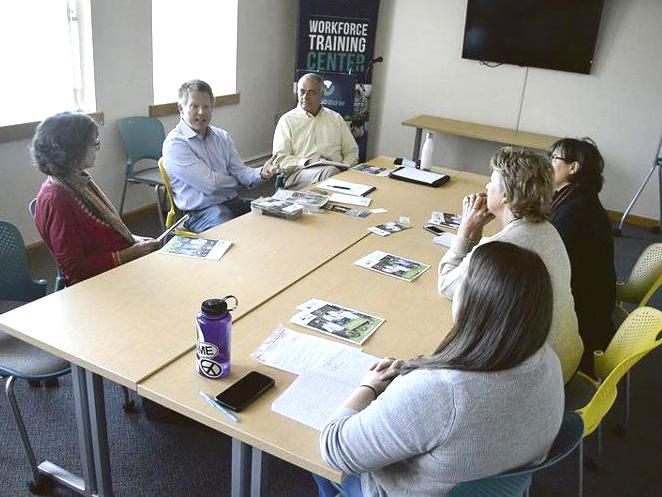
Growing Hope Globally CEO says goal is to connect with farmers
This article was originally published in The Daily Star, Oneonta, NY.
By Sarah Eames, Staff Writer
ONEONTA — Max Finberg (above, middle left), president and CEO of Growing Hope Globally, an international nonprofit humanitarian organization, met Wednesday with local farmers and representatives from regional agriculture programs to discuss opportunities for global outreach.
Finberg, a Margaretville native, discussed the history of Growing Hope Globally, which was officially chartered in 1999 as the Foods Resource Bank.
“The reality was we’d always used food as a tool for hope,” Finberg said.
Now in its 20th year, Growing Hope Globally operates a farmer-led model for growing projects that seek to involve other individuals and groups in the surrounding community, Finberg said. The goal is to get farmers involved and pair them with organizations already doing projects on the ground, he explained.
“All we need is somebody connected to agriculture with a big heart,” Finberg said.
Finberg likened the structure of the program to the European folktale about stone soup, in which community members with seemingly little to offer individually come together to make a community meal.
“It’s really neat to bring folks together for a cause,” Finberg said. “No one farmer, no one organization, no one community has to bear the whole weight.”
Growing Hope Globally receives no government funding, Finberg said; relying instead on partnerships with about a dozen faith-based humanitarian service organizations, including Catholic Relief Services, Lutheran World Relief and the Mennonite Central Committee, which operate a combined total of 44 boots-on-the-ground food security programs overseas.
“The appeal is knowing what the projects are,” Finberg said.
The organization funds the initiatives in a three-year cycle, investing an average of $12,000 a year into each growing project, which has an anticipated lifespan of seven to eight years, Finberg said.
He described a program in Guatemala, which has the highest rate of malnutrition in the western hemisphere, in which program staff train and employ local residents to travel between communities, teaching people how to grow in gardens and in greenhouses.
“You take these subsistence farmers — almost exclusively women — and all of a sudden they’re entrepreneurs,” Finberg said.
“We don’t do the relief, we don’t provide any food — it’s all development,” he continued. “We don’t implement anything. We’re a funder.”
The model is sustainable, said Jim Barber, the agriculture implementation specialist for Cornell Cooperative Extension of Schoharie and Otsego counties. “You’re not shipping food over. You’re shipping resources over.”
The organization is based in the midwest, with its strongest presence in Michigan, Illinois, Indiana and Iowa, according to Finberg.
“We have only one program in the entire Empire State,” Finberg said, adding that he observed a lot of potential, especially given what he described as New York farmers’ increased interest in value-added products in recent years.
“New York farmers are already extremely generous,” Finberg said, noting that many donate surplus products to local food pantries.
Some local partners host community dinners and donate the proceeds to their program of choice, Finberg said.
Participating farmers are encouraged to donate in any way they can, Finberg said, even if it’s a small plot of land for use by a local FFA chapter or school agriculture class. Growing Hope Globally sponsors a curriculum with FFA, which is available for download on the organization’s website, Finberg said.
“I like this concept of having community partners,” Barber said.
“Connecting to local churches is the place to start,” said East Meredith resident Susan Dapkin.
“It starts with conversations like this,” Finberg said. “For folks connected to agriculture, this is a pretty unique way to engage. The creativity is limitless — that’s why we say there’s no one-size-fits-all.”
For more information, contact Finberg at max@growinghopeglobally.org or visit growinghopeglobally.org.
